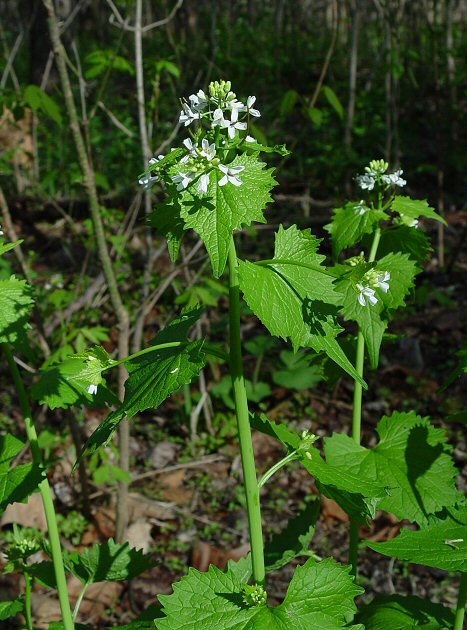Alliaria petiolata (M. Bieb.) Cavara & Grande
Garlic Mustard

Introduced
CC = *
CW = 3
MOC = 36
© DETenaglia
Alliaria petiolata (M. Bieb.) Cavara & GrandeGarlic Mustard | |
 |
Introduced CC = * CW = 3 MOC = 36 |
© DETenaglia |
|
Family - Brassicaceae Habit - Biennial forb. Stems - To +1m tall, herbaceous, single or multiple from thick taproot (with a radishlike aroma when crushed or bruised), erect, branching above, pubescent at very base, glabrous and glaucous above.
Leaves - Alternate, glabrous above, sparsely pubescent below. Basal leaves reniform, crenate or sinuate, petiolate, to 10 cm broad, 8 cm long. Petiole to 15 cm long, with single longitudinal groove, groove ciliate on margins. Cauline leaves gradually reduced upwards, cordate to sagittate, sinuate to coarsely toothed.
Inflorescences - Terminal racemes, greatly elongating in fruit.
Flowers - Petals 4, white, glabrous, clawed (the claw to 2 mm long), 6-7 mm long, 3 mm broad at apex. Stamens 6. Filaments to 3 mm long, glabrous, white. Anthers yellow, 1 mm long. Ovary green, 4-angled, 3 mm long, glabrous. Style very short. Sepals 4, whitish with light green tips, 3-4 mm long, 1-2 mm broad, linear to subulate. Pedicels to 4 mm long, glabrous.
Fruits - To 5 cm long, 4-angled, glabrous, on thick stalk to 6 mm long, erect and parallel to stem, many seeded, style persistent as a short beak. Fruit stalks at right angles to stem.
Flowering - April - May. Habitat - Low woods, slopes, streambanks, roadsides, railroads. Origin - Native to Europe. Lookalikes - None close. Leaves can resemble those of Glechoma hederacea and Asarum canadense. Other info. - This plant is infamous as a noxious invasive of moist, shaded areas. It is particularly troublesome in northern areas of the U.S., but rare or absent in much of the southern U.S., and probably less of a problem in Missouri than in the northern regions. Once established, it is difficult to eradicate, having self-compatible flowers and seeds which remain viable in the soil bank for many years. Conventional wisdom asserts that seeds will continue to mature on plants which have been uprooted at an immature stage; thus collected plant material should be burned or removed from the area. Photographs taken at Eagle Bluffs Conservation Area, Boone County, MO., 4-11-04 (DETenaglia); also near St. Albans, Franklin County, MO, 4-6-2010, and Riverfront Park, Washington, Franklin County, MO, 4-16-2021 (SRTurner). |